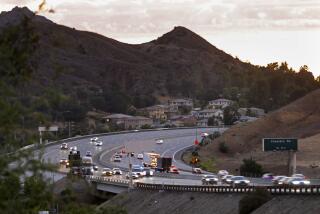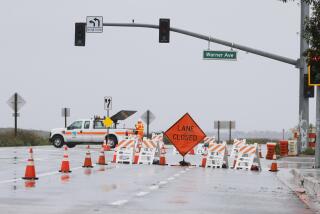Agency seeks to again refinance struggling San Joaquin Hills toll road
The operator of the largest toll road network in the western United States is preparing to refinance one of its struggling highways — for a second time
The road is the San Joaquin Hills (73) toll road through the coastal foothills of Orange County, which has failed for years to meet its ridership and revenue projections.
The plan by the Transportation Corridor Agencies based in Irvine could improve the highway’s bottom line, but motorists might have to pay tolls up until 2050 — an extra eight years — to retire the road’s debt.
Tollway officials and their consultants are considering refinancing at lower interest more than half of $2.1 billion in bonds that were sold to build the San Joaquin, which courses through the hills between Newport Beach and San Juan Capistrano.
Though the restructuring will increase total debt payments, officials say that the proposal would lower the highway’s monthly interest payments, improve cash flow and increase financial flexibility. The measure could also protect the highway’s credit rating and reduce the pressure to increase tolls.
If approved, the planned refinance would be the second time the agencies have restructured the highway’s debt and postponed the day when the road would be free to motorists. A May 2011 refinance pushed back the original payoff date six years from 2036 to 2042.
Lisa Telles, the Transportation Corridor Agencies’ chief communications officer, said a restructuring proposal could go before the San Joaquin Hills board as early as Sept. 25.
“The road is below original projections, but we are living within our means,” she said.
Since it opened in 1997, the San Joaquin has consistently fallen below its revenue and ridership projections as debt payments have risen. The road, which relies on tolls and fees from new development, has been battered by tough financial times, overly optimistic projections, lower than expected population growth and competing public highways.
But Telles said the tollway’s ridership and revenue have improved in the last several years.
Similar financial problems surfaced last year for the agencies’ other highway network, the Foothill-Eastern, which includes part of California 133 in central Orange County as well as California 241 and 261 from Yorba Linda to Rancho Santa Margarita.
In December, the agency refinanced $2.3 billion in bonds at lower interest to improve the system’s outlook. The measure extended the time that motorists must pay tolls on the Foothill-Eastern by 13 years — from 2040 to 2053 — and added more than $1.75 billion to total interest payments by the time the bonds mature.
A study released in July 2013 by a debt advisory commission overseen by the state treasurer indicated that the Foothill-Eastern would be at risk of defaulting on its bonds if the operation wasn’t refinanced to lower it’s annual debt payments.
Twitter: @LADeadline16
More to Read
Start your day right
Sign up for Essential California for news, features and recommendations from the L.A. Times and beyond in your inbox six days a week.
You may occasionally receive promotional content from the Los Angeles Times.







